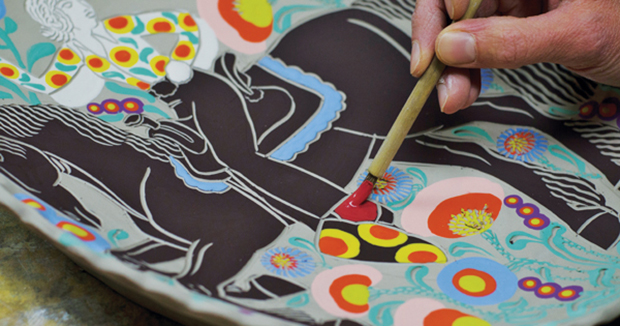Unveiling the Artistry and Techniques of Sgraffito – Art is a realm of boundless creativity, where techniques breathe life into visual expressions. Among these techniques, sgraffito stands out as a method that adds texture and intricacy to artworks across various mediums. In this article, we delve into the artistry of sgraffito, exploring its types, notable artists who embraced it, its application in ceramics, and its significance in the visual arts.
Exploring the Types of Sgraffito
Sgraffito comes in different forms, each carrying its unique charm and appeal: slot
- Scratchboard Sgraffito: This type involves scratching a surface, typically coated with layers of contrasting colors, to reveal the underlying colors. It’s commonly used in illustrations and printmaking.
- Ceramic Sgraffito: In ceramics, sgraffito entails incising or carving patterns, designs, or textures into clay. The carved areas are often left unglazed, creating a beautiful contrast between the raw clay and the glazed surface.
- Painting Sgraffito: Artists use this technique by layering different colors of paint and then scratching or etching the top layer to reveal the colors underneath. It’s widely used in acrylic and oil painting to achieve intricate details and textures.

Renowned Artists and Sgraffito
Antonella Prota Giurleo: An accomplished artist known for her exquisite scratchboard sgraffito artworks, Giurleo’s pieces showcase intricate details and patterns, often inspired by nature.
Piero della Francesca: This Renaissance master utilized sgraffito technique in his frescoes, adding depth and texture to his works. His adept use of this technique is visible in the “Resurrection” fresco in Sansepolcro, Italy.
Sgraffito Technique in Ceramics
In the realm of ceramics, sgraffito is a captivating technique that involves the careful carving of patterns or designs onto the surface of the clay before firing. After the clay is bisque-fired, colored slips or underglazes are applied to the surface.
The artist then gently scratches away the top layer to reveal the contrasting clay color underneath. This technique allows ceramicists to create intricate patterns and personalized designs on their pottery, adding both visual and tactile interest.
The Meaning of Sgraffito in Visual Arts
The term “sgraffito” has Italian origins, derived from “sgraffire,” meaning “to scratch.” In the visual arts, sgraffito refers to the act of scratching or incising a surface to create a contrast between the layers, resulting in visually striking artworks. This technique has been used for centuries in various cultures and artistic traditions, from frescoes in Italy to scratchboard illustrations.
Conclusion
Sgraffito is a captivating technique that enriches artworks with depth, texture, and intricate details. Whether applied in scratchboard illustrations, ceramics, or painting, sgraffito showcases the skill and creativity of artists across different mediums.
From the Renaissance frescoes of Piero della Francesca to the contemporary scratchboard artworks of Antonella Prota Giurleo, sgraffito continues to captivate art enthusiasts with its ability to transform surfaces and bring visual narratives to life.
Whether it’s the delicate etchings on a clay pot or the scratchboard masterpiece on paper, sgraffito adds a layer of artistry that draws viewers in and invites them to explore the world of texture and pattern.